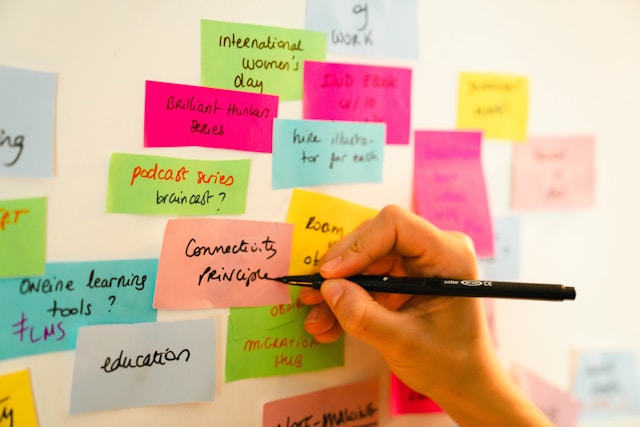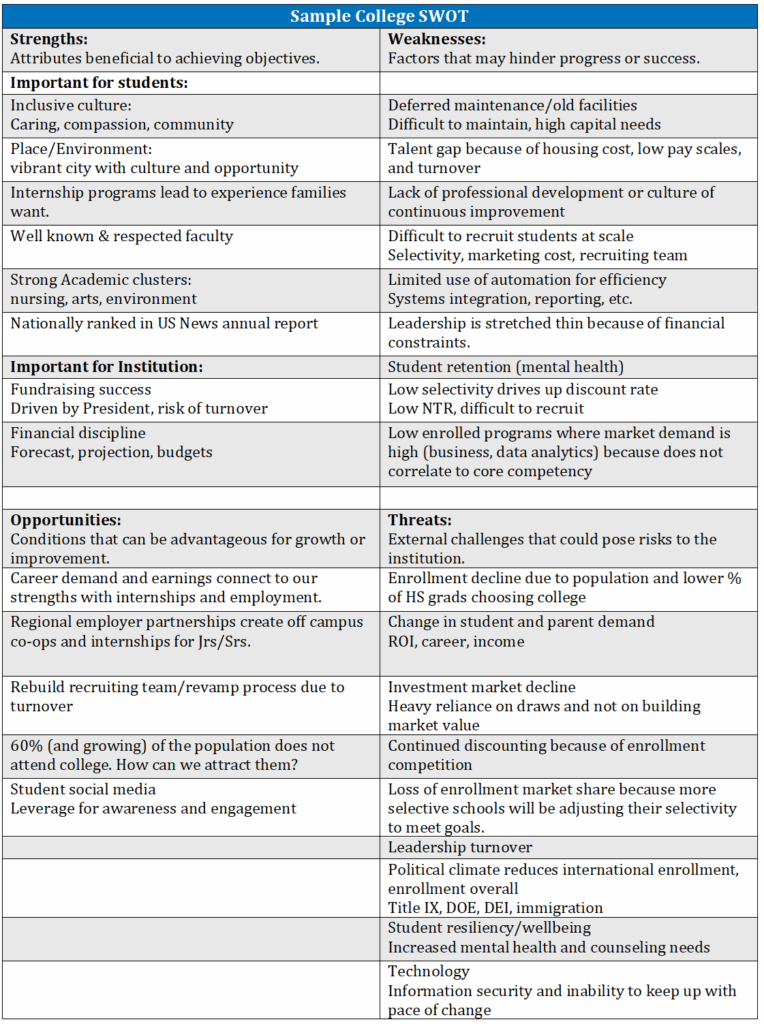
It’s a great time for a SWOT analysis of higher education
SWOT analysis is a valuable tool that helps institutions understand their competitive position and make informed strategic decisions. By evaluating internal and external factors, institutions can identify areas for improvement and growth, ultimately enhancing their chances of success in this highly competitive environment.
A SWOT Analysis provides a structured approach to gathering feedback and ideas and distilling that feedback into actions a company can take to grow, change, or reimagine itself. It examines the company from internal and external perspectives. With so many external risks circling us like sharks, this is a great starting point for strategic planning.
There are many similar definitions and suggested approaches, but what I want to focus on are some ways this can be beneficial in higher education.
What is SWOT Analysis?
SWOT stands for Strengths, Weaknesses, Opportunities, and Threats. It is a framework that can help an institution assess their internal capabilities and external environment to inform strategic decision-making. The analysis enables us to gather insights into the factors that impact an institution’s success and identify areas for improvement and growth.
Who should participate in this process?
To be effective, SWOT exercises should include cross-functional groups of people and generally be broader than the core leadership team. If there are groups of influencers on your campus, include them, as well. Representatives from student government, faculty senate, schools, and major departments are welcome. A good size is 20-60 people depending on the size of your institution.
Think about what stakeholders can create buy-in for new initiatives across campus. This often means including voices of dissent. Also consider your strategic and creative thinkers — the ones who excel at coming up with new ideas.
How should you approach SWOT analysis?
First, this is not a 1-hour exercise. If done correctly, it takes a full day. I have a bias toward sticky note exercises when I work with large groups with different perspectives or those reluctant to volunteer ideas. By taking a large group of people and breaking them into cross functional groups of 6-8 people, you have the best chance of sparking meaningful dialogue. The exercise starts by giving each participant a pad of 4 x 4 sticky notes and asking them to write down as many strengths of the institution they can think of in 5 minutes. At the end of that time, each person discusses and shares their ideas within the group. Then, they group ideas together by theme. I like to do this on a wall or whiteboard. The group discusses and agrees on the language of the top strengths and how to articulate them.
Conversations lead to decisions
I was working on a strategic planning exercise with a client several years back. They spent over a year developing a strategic plan but could not get it approved by internal stakeholders, so they hired Howard Teibel and I to help solve their problem and connect the plan to finances. After weeks of conversations, the plan was finalized and approved. What was most interesting is that the plan was not substantively different from their original plan. What differed was an internal understanding and alignment created through conversations around a whiteboard. Working with people you do not usually work with while you debate the meaning of a single word or phrase is actually quite effective. I find it fascinating that even in my own work, I can use a term like “target” and think that it depicts a range we are trying to achieve, but a president would take it to mean something very specific. By making time for these conversations over a word, it creates common language and shared understanding of the problem you are trying to solve or common understanding of your strengths.
I like to add a little twist here where I then ask them to articulate whether the strength is a benefit to students, faculty & staff, or external stakeholders. Of course you can use whatever groupings are meaningful to you. By asking this, we learn whether we are only looking at this from an internal lens or whether we are considering the students we serve.
The ground rules are critical to success
This exercise needs to be held in a safe space, free of criticism and open to constructive honesty.
- Stress quantity, not quality. The goal is to get everyone to think and share their ideas. Too often we limit our ideas and conversations because some voices are louder, or others believe their ideas may not be valid.
- All ideas are good, and should be approached as “yes, and…”. Avoid using “but” and we can’t or that won’t work statements. This is a good rule for conversations in your life as well.
- Each group needs to select a representative who can help enforce the ground rule, move the conversation along, and share the high-level feedback with the other groups.
Define your Strengths & Weaknesses – Internal Examination
It starts with an Internal assessment of your institution to define Strengths & Weaknesses. This is a great place to engage internal stakeholders in a conversation about your shared beliefs of the institution’s core competencies. It also provides valuable insight and alignment into areas where the group believes your institution should and could do better. Using the approach suggested above, start with strengths, then weaknesses. Do not mix the two. At the end of strengths, each group’s representative should share with the others and discuss.
The larger participant groups should discuss and debate the top strengths and to what audience they apply. Do not try to achieve complete alignment at this stage, you will have time throughout the process.
Assessment of Opportunities and Threats – External Examination
Next is an external factor assessment of Opportunities and Threats facing your institution. These include things like market trends, regulatory changes, economic conditions, technological changes, etc. I highly recommend starting this part of the process by asking all participants to read Jeff Selingo’s brief, The State of Higher Education 2025. This provides an excellent framework for many of the most profound factors facing higher education. Of course, we cannot forget what is happening in Washington, D.C. Immigration changes, changes to the Department of Education, and the One Big Beautiful Bill may all come into play.
Then, we start the same sticky note exercise by writing down Opportunities that do or can exist and discussing them before moving onto threats. Opportunities arise from external forces that could create additional opportunities for you. I believe every threat can be turned into an opportunity, so I often start with threats. For example, one major threat is that fewer high school graduates are choosing to go to college because of the perceived lack of value. This means that over 60% (and growing) of the population does not have or seek a degree. The opportunity here is in that potential market. How do we create a learning experience which is valuable to that population segment at a price they are willing to pay?
At the end of each section, we come back together as a group to share and discuss and have a healthy debate around which ones rise to the top.
What do you do with this information?
- Congratulate yourself; you have started a healthy campus engagement process.
- Capture all conversations and share back with the group.
- Suggest the next steps. For example, do you need to set aside another 2 hours to prioritize the opportunities you want to explore?
- Identify working groups to explore opportunities and decide who will be part of these groups. Be clear about their tasks and timelines. Each working group should report back into a larger steering committee (or President’s Cabinet). Introduce these groups to design thinking as a process to solve problems and identify new ways to meet customer needs.
Develop Strategies
By approaching the SWOT Analysis with an openness to listen and share perspectives, you can prioritize your approach to long term sustainability.
The difficult part of this analysis is the dialogue that comes next. What should your institution prioritize and how will you approach that work? This provides the foundation to the process of reimagining the future of your institution.
Use the insights gained from the analysis to formulate actionable strategies that leverage strengths, address weaknesses, capitalize on opportunities, and mitigate threats. In fact, I like to focus on threats and ask, how can we leverage our strengths to turn threats into opportunities? Which weaknesses do we need to address to realize these opportunities? This approach will help prioritize initiatives. This is a great opportunity for a design thinking sprint. I discuss design thinking in this article.
Here is a sample SWOT Analysis. I’d love to hear your thoughts on what is missing from a higher ed perspective.

Rebeka Mazzone, FuturED Finance
Photo by Kit (formerly ConvertKit) on Unsplash